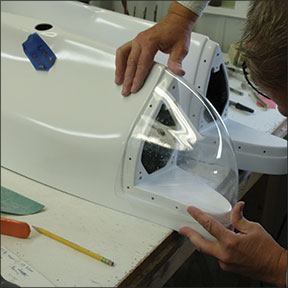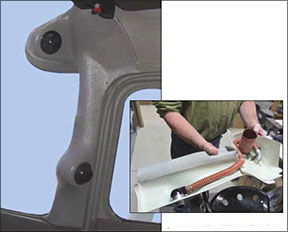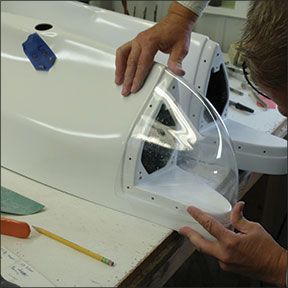Whether a part on your aircraft is damaged or worn, it’s logical to look to the aftermarket for a replacement. While the buying decision might be based on the high price of OEM replacements, there are many benefits to aftermarket replacements. For one, the part could be made from more serviceable material, including fiberglass. This could also yield a weight-saving advantage.

Still, there are some caveats. Not all replacement parts will easily bolt on. There’s fit and finish considerations, plus you’ll want to source aftermarket parts from a reliable and experienced manufacturer, while ensuring the part has proper FAA certification. You could end up spending more money if your shop has to modify the part to make it fit or obtain FAA approval to put it on.
One company, Knots 2U—the maker of speed and efficiency mods—is ramping up production of replacement fiberglass parts. I recently visited with Knots 2U for a firsthand look at the manufacturing process. In this article I’ll explain what it takes to install these parts.
History
Burlington, Wisconsin-based Knots 2U has been around for over 30 years. It’s had a hand in increasing both the top and low-end speeds of a number of models, starting with Jim Bradshaw’s work on his Piper Twin Comanche.
Tricky little airflow management items sped up the airplane an additional 20 MPH. Since then—and with much success—the company began carving a niche for themselves in the speed business. Jim Bradshaw passed away much too early, but his desire for speed lives on in the company he founded.
The company has grown into a business known in aviation circles for producing some of the highest quality fiberglass in the industry. Knots 2U’s fabrication shop not only produces parts for themselves, but is also a supplier to several OEMs.
Having a capable crew, it was only natural that the company began manufacturing and certifying replacement parts, using a combination of fiberglass, plastic and aluminum.
In December 2011, it purchased Globe Fiberglass of Lakeland, Florida. The purchase added over 320 new items to its already large inventory of parts. It included the materials, plugs, molds and most importantly, the paperwork that had been developed over the past 30 years. That has huge value because the FAA approval process is a long and challenging one that ultimately is passed along to the consumer. It also allows Knots 2U to bring new replacement parts to market more quickly.
Globe’s Problems
When it was announced that Knots 2U had purchased Globe, there was some head-shaking throughout the industry. Globe had a bit of a reputation. Its parts generally looked good, but proper fit was a crapshoot. Sometimes a part fit, sometimes it didn’t. Globe always made good on a bad part, but sending out ill-fitting parts slowed down projects.
About a dozen or more years ago, I was rebuilding a Piper Tomahawk. I opted to use Globe as I was a devoted fiberglass guy, knowing that the parts would be mostly indestructable, while also repairable. I had only had marginal luck repairing plastic parts with ABS cement, since most parts were drawn to such thinness, there was no real substance. I was surprised when the first part, a front door post and side panel, came nowhere close to fitting. Parts were either too wide, too tight, or the angles or curves were off. The rigidity of the fiberglass did not allow for any flex. Thinking it was an aberration, I tried the next part and found the same thing.
In all out of seven parts, I was able to use four of them (and this was after modification). Even then the parts did not fit as I would have liked. I learned the real downside of fiberglass parts: If they are not built correctly, they can never be right.

In talking with John Bailey, owner of Knots 2U, about the Globe interior part problem, he relayed the story from Globe. According to lore, Globe PMA’d a series of interior parts for the Piper Tomahawk as we’ll as several Piper PA-28 and PA-32 models, but soon realized the fiberglass layup called out in the original drawings was simply too rigid and needed to be revised. Attempts were made to change the layup formula, but the FAA dug in their heels and wanted a complete substantiation report before the changes could be made. Globe quickly shelved the product line and only produced an occasional part.
With the Globe purchase, Bailey and crew also inherited a handful of the Globe problems. Having perfected their methods for producing fiberglass parts, Knots 2U knew they had their work cut out for them. Developing a proper part isn’t as cut and dried. Certain things have to be done.
First, they had to separate the wheat from the chaff, as they say. Containers of molds, OEM original parts, plugs and fixtures made their way to Wisconsin. Current production molds were separated from the out-of-production tooling and plugs, plus thousands of items had to be sorted and shelved. The most important thing Knots 2U bought, though, were the volumes of approved drawings and data.
One of the first updates Knots 2U made was to upgrade to new standard resin to replace the old out-of-date resin used by Globe. While it was a high-quality resin back in the day, it had to be replaced by new and much improved formulas. To do this, Knots 2U had to get approval from the FAA before any changes to the resin or layup could be made. This meant hundreds of engineering hours and drawing revisions.
Cosmetics Matter
At some point everyone has to stand back and take a long look at the replacement parts they buy for their airplane, particularly when it comes to fairings, fillets, wing tips, interior parts and other cosmetic pieces that are the finishing touches to any project. If the finishing touches suck, then the entire project sucks. This is the ultimate testament about any replacement part you buy for your airplane. How can you be sure it will fit? How do you know you are getting your money’s worth? How do you avoid hours and hours of fitting and modifying an aftermarket part to replace an original OEM part? This aspect of refurbishing an airplane is the so-called leap of faith an owner or mechanic has to take when choosing a supplier.
In my estimation, buying an aftermarket part instead of OEM replacements is a smart decision. Most of the time, aftermarket parts are half to one-third of the price of factory replacement parts and in many instances a higher quality. But when you shop the aftermarket, you have decisions to make. You or your mechanic will have to fit the part. This means drilling holes and trimming the component on your own. In addition, you will have to paint it. Both ABS plastic and fiberglass parts require painting for “finish out” and UV stabilization.
Aftermarket cosmetic parts will often be plastic, like the original, or fiberglass. Both have their long and their short suits. Plastic will come in different shades of white, off-white or black and fiberglass will come either primed or gel coated. What’s the difference between plastic and fiberglass? It’s all about cost and durability. Plastic is usually cheaper and fiberglass is more durable.
The differences in prices are in the actual making of the part. Both plastic and fiberglass parts have to start with a plug, from which is made a mold. Plastic parts, usually ABS or Kydex, can be fabricated using either male or female molds, while fiberglass molds are usually female. When making a part, heat and vacuum is used for the plastic parts, while fiberglass parts are laid up by hand, with some vacuum bagging. Many of the parts have to be mated and seamed. All of them have to be finish-trimmed, inspected and labeled. After the initial prep, plastic parts can be built rather inexpensively and quickly, as a number of molds can be fitted into the vacuum machine and in just seconds, several parts can be formed, awaiting final trim to size. Fiberglass parts involve sizable amounts of labor to hand lay-up the part in a mold—one at a time.
Improving Quality
So far, Knots 2U has been able to rework about 90 percent of the Globe fiberglass parts for fit, finish and aircraft eligibility. On parts where fit was an issue, molds have been reworked or completely replaced. Aircraft eligibility has been updated on many parts. In some cases, parts were incorrectly approved for models they did not fit; in other cases, models were added to the eligibility list. Bailey states they still get some poor fitting issues, but they are becoming few and far between.
The resin used is stable at different temperatures and is flexible enough to allow some bending without cracking. The controlled manufacturing environment ensures stability of the plugs and molds as they are being developed, built and stored. K2U’s record of few warranty claims is a testament to its efficiency.
Of the 18 employees, 14 of them are involved in manufacturing. Common parts are typically in stock for immediate shipment. The next most common group of parts are built and kept in the mold until an order comes in, or until time allows staff to pull and finish the part for inventory. The least common parts are made to order, a process that can take from just a few days to a couple of weeks, depending on the complexity of the part.
A 10,000 square-foot-building—equipped a state-of-the-art climate control system—was recently added to ensure an optimal manufacturing environment. Office space, inspections, assembly of parts (including wing tips with light lenses and their popular AeroVent door posts) fill the old building, along with an inventory of numerous parts provided by other vendors, including those sourced from Texas Aero Plastics.
Knots 2U markets products from a number of vendors to enable a buyer to purchase a complete replacementpart assembly. For example, if an owner wants a wing tip with nav and recognition lights with newer LED parts, the company can ship it in a ready-to-install state (including paint). As the sidebar on page 18 describes, it isn’t always this easy. Many parts will need to be fitted and finished. This creates additional expense and downtime.
One of the newer projects the company is creating is a website for owners interested in speed increases. Whether you are a Reno Racer or you just want to beat the Bonanza a couple of hangars down, this site will be an open discussion of any and all parts, philosophies and techniques used to speed up an airplane. Competitors are asked to participate, and racers, endurance guys and aerodynamic engineers are slated to provide material.
The speed mod business is pretty competitive, but most players have the same goal. Bailey is hoping that anyone with anything to say about speed or efficiency will contribute and that owners and aspiring racers will get involved. This site should be launched in early 2014. While the Globe transition is keeping the company busy, it continues an effort that’s focused in the speed business.
OEM Surplus
A final note on sourcing parts. As impressed as we were with Knots 2U and its fiberglass production, it isn’t the only replacement part option. Aside from a variety of plastic replacement parts vendors (some offering certified parts, others not), there’s also discounted OEM parts. One respected source, Preferred Airparts, buys surplus OEM inventory in addition to parting out used aircraft. We talked with a few shops that source parts from Preferred and all had good things to say about the company’s supply of surplus Cessna parts.
Last, no matter which replacement part you buy, someone needs to sign off the installation. If you want to manufacture your own part, consider that there are structural and burn specifications that need to be met. That could squash the idea.





